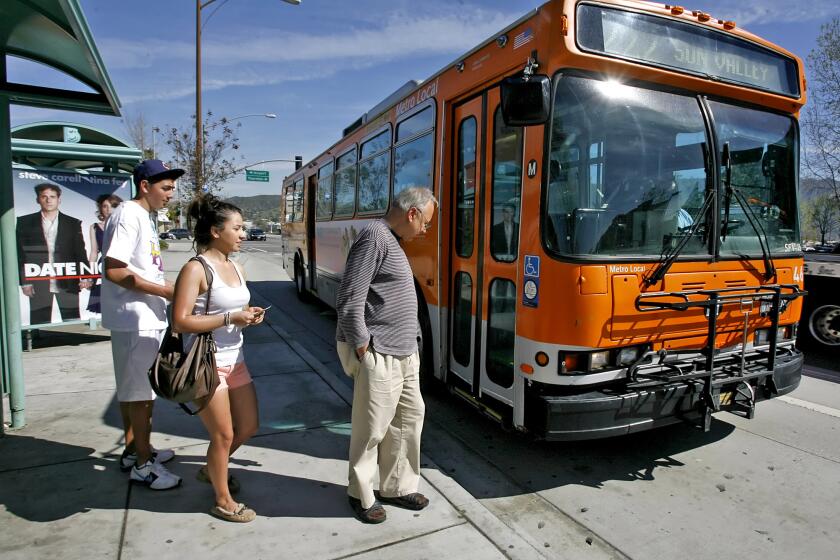Judge Slaps L. B. for Bid to Freeze Airport Use
Saying he would not acquiesce in the City of Long Beach’s “policy of delay,” a federal judge refused this week to postpone implementation of his order for eight more airline flights at Long Beach Airport.
U.S. District Judge Laughlin E. Waters in Los Angeles rejected a motion by the city to freeze the number of daily flights at the current 18 until an appellate court decides the issue. However, the increase is not expected to take place at least until February.
“The city has been fighting a delaying action here.” Waters said Monday. “ . . . The city has continued in its policy that delay is the best position it can occupy.”
Waters, who in 1983 found a city airport noise ordinance arbitrary and increased flights from 15 to 18, said the city took far too long to draft the new noise ordinance it adopted this summer.
Now, he said, it is time to consider “the needs of the traveling public.” Waters said he is “not that familiar” with Long Beach but he assumes that it, like the rest of the Los Angeles Basin, is growing and needs more airline service.
Appeal of Order Plan
City lawyers said that they will now ask the U.S. 9th Circuit Court of Appeals to delay the new flights until that court can rule on whether Waters’ Oct. 17 order for more flights was proper.
Waters also set a hearing for Jan. 5 to hear arguments from about a dozen competing airlines that want the new flights.
City and airline attorneys said they do not expect Waters to rule on a flight-allocation plan at the Jan. 5 hearing, so new flights probably could not be expected until at least February.
Recent hearings about flight increases are part of a larger case concerning city airport noise controls that will not be heard until next year.
A trial before Waters on the city’s new noise ordinance and on how many flights Long Beach may ultimately have is not expected until after the Federal Aviation Administration submits its analysis of the ordinance in January.
The number of airline flights at Long Beach Airport has been under Waters’ control since 1983, when airlines sued for greater access. After the judge found that the city’s previous noise ordinance lacked sufficient technical foundation, the city appointed a task force to study the matter under the aegis of the FAA.
In July, the City Council adopted an ordinance based in part on the new task force data. Though the new ordinance allows fewer flights than the task force recommended, the council said it takes into account both the effects of airport noise on nearby homeowners and legal pressure from airlines and the federal government to increase flights to at least 40 a day. (One flight comprises a takeoff and a landing.)
The ordinance allows airline flights to increase slowly from 18 to 32, but only if aircraft noise is lowered and then kept within state-endorsed levels for adjacent residential areas.
Failed Court Test
However, the new ordinance failed its first court test in September, when Waters said he had “serious questions” about its legality and refused to allow its implementation.
City officials have said for months that, if necessary, they will take their case to the U.S. Supreme Court to maintain local control of the airport. And Waters said this week he suspects that the case will finally be decided by the high court.
Lee L. Blackman, the city’s lead lawyer for airport matters, said he plans to argue on appeal that federal law requires only equitable allocation of flights within a reasonable noise standard. No level of airline service is mandated by law, he said.
In a statement to attorneys Monday, Waters took specific exception to part of the new city ordinance that effectively limits the ultimate number of flights to 32, rather than 41 recommended by the task force.
Shorter Runway Backed
The task force recommended shifting private jets from the airport’s main runway to a shorter one alongside the San Diego Freeway. The task force said that would allow more flights because noise would increase in industrial areas, not the residential ones protected by noise standards.
But the City Council decided that it did not want to decrease noise on one side of the airport by increasing it on another.
That council move, said Waters, “was very carefully tailored . . . to make sure it’s virtually impossible to meet the (noise standard) with 26 flights.”
The new ordinance says flights can only be added after airport noise is reduced to state-sanctioned levels. It requires a reduction in noise through the use of quieter aircraft and operating methods before any new flights are allowed.
But the five airlines already at the airport say they will have no incentive to reduce noise if they have no hope of receiving the extra flights.
The city--in line with the federal Airline Deregulation Act of 1978--has said the flights should go only to carriers not now at the airport.
More to Read
Start your day right
Sign up for Essential California for news, features and recommendations from the L.A. Times and beyond in your inbox six days a week.
You may occasionally receive promotional content from the Los Angeles Times.






